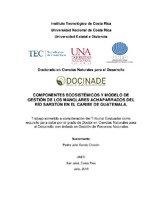Componentes ecosistémicos y modelo de gestión de los manglares achaparrados del Río Sarstún en el Caribe de Guatemala
Resumen
The study was carried out in the stunted mangroves of the Sarstun River ecosystem
on the Caribbean coast of Guatemala. The low basin of this river in the Department
of Izabal marks the border between Guatemala and Belice. The goal of this research
was to characterize the stunted mangrove of the Sarstún River ecosystem, in order
to propose a management model for the protection, conservation and use of this
ecosystem. To characterize the ecosystem the environmental variables that
regulate it, environmental variables were determined, to establish its current stage,
the mangrove structure and composition was determined to establish its biophysical
stage, and the composition of the fish community present in the ecosystem was
analyzed, to know their spatial and temporal distribution, and a management model
for the protection, conservation and use of the mangrove is proposed.
Five study sites with two transects and three parcels each were selected. In each
parcel samples were taken for physico-chemical analysis of sediments and
interstitial water were made, mangrove morphometric measures and surface water
quality analysis. Fish samples were also taken to quantify the number of individuals
of each species, in order to determine their spatial and temporal distribution. With
the information obtained, correlation analysis, analysis of variance, comparison of
means and analysis of site similarity were made. This led to the conclusion that
environmental variables limit the mangrove development and show a trend to a
reduction in the case of precipitation and days of rain in the area. The mangrove
structure and composition remain with little variation, it is evident that exists a high
connectivity in the ecosystem. The number of fish species and the amount of
organisms of each species is higher in the rainy season. From these results it is
proposed a management model oriented to maintaining the ecosystem functions
under an organizational structure in the human sphere, in a type of consortium
integrated by users, administrators and the scientific community.
Descripción
Tesis (Doctorado en Ciencias Naturales para el Desarrollo con énfasis en Gestión de Recursos Naturales) Instituto Tecnológico de Costa Rica. Universidad Nacional. Universidad Estatal a Distancia, Doctorado en Ciencias Naturales para el Desarrollo, 2015.


